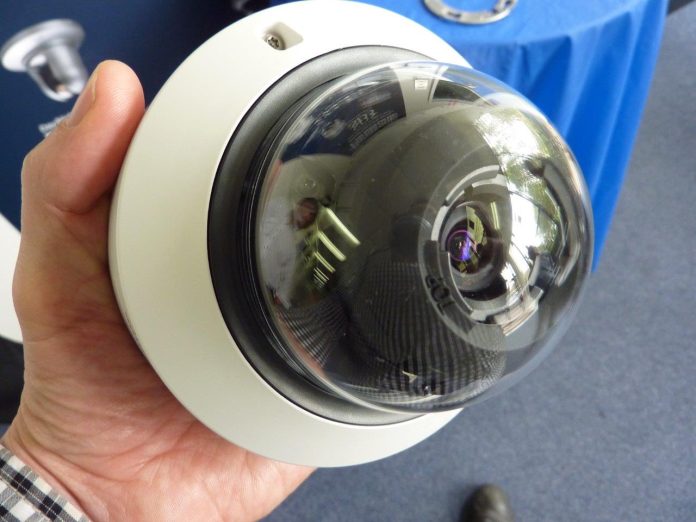Panasonic’s latest release in the hotly contested 1080p and 720p IP camera market, the iPro Smart HD 6 Series, is a strong contender that combines strong image quality across a range of tough applications with plenty of back-end smarts.
THERE’S no doubt that the cadence of new releases in this pivotal part of the CCTV camera market has picked up. A small group of highly committed manufacturers is competing to offer the best performance in key areas like low light, WDR, noise reduction, motion blur and bit rate management.
The task they face is a challenging one. If you want better low light performance you wick up gain. If you want less noise you pump up noise reduction. But when you elevate noise reduction, you increase motion blur on moving parts of the scene. If you focus your camera engine’s attention on moving parts of a scene you tend to flatten the static areas during movement – the result is a loss of resolution, contrast and colour rendition. Choke your bit rate and you lose resolution when sudden movement bursts across an idle scene. It’s a balancing act and not an easy one.
Digital camera development is harder than it was in the days when analogue manufacturers simply built new CCD sensors with additional horizontal resolution or re-designed AGC. With digital there are layers upon layers, as camera technology becomes more complex. There’s optics, sensing, storage, compression, comms, processing – image enhancement and IVA – as well as mechanics to consider. Meanwhile, the hidden nature of digital processing makes specification comparisons impossible.
I get a look at the new 6 Series at Pacific Communications Rydalmere office with Panasonic’s Hiroshi Sekiguchi, manager IP security product MD, Marcus Vongpraseuth, product marketing manager security and intercom and Satoshi Kawakami, staff engineer, electrical engineering group. Sekiguchi and Kawakami have flown over from Japan to demo their new camera and I get a distinct feeling this unit is still in the process of evolution.
Sekiguchi doesn’t stop talking about improving the new product, which is nice to see. An obvious technophile, Sekiguchi is delightfully candid and he talks about the challenges of the development and the strengths of particular competitors in very revealing ways. It’s nice to know the Panasonic people look at the best cameras on the market with their eyes wide open, then seek to leap-frog them with enhancements and developments of their own. Sekiguchi concedes Panasonic has had some work to do to take its cameras back to the head of the pack but it’s clear he believes that with the new Uniphier camera platform built into the 6 Series, this is in the process of being achieved.
“New enhanced Uniphier is the first camera platform I’ve been involved with from the start and I’m very happy and excited about it,” Sekiguchi tells me. “With this release we are really aiming to be the best camera manufacturer – we have spent the past couple of years going back to basics and trying to exceed the market’s expectations. We want to attain the superiority in cameras we had in the past.
“To achieve this goal we have focused on achieving the best images in any application – whether it’s sunny, cloudy, day, sunset, night, extreme temperatures (55 plus 60 below). We want the best images in real time to support any security operations.”
We knew this already but Sekiguchi points out the fact that Panasonic doesn’t play around with specification sheets.
“We don’t like doing that – we play with actual performance,” he says. “For instance, with this camera we have 133dB Super Dynamic – one of the leading competitors is 130dB and another is 120dB – so we are back to the front line with this new Series 6,” he explains.
As he tells the story of 6 Series development, Sekiguchi makes a key revelation concerning Panasonic’s philosophy – while basic functions are important, raw camera innovation is important, too.
“One customer might need more low light performance, another more Super Dynamic, another more WDR, or IR support, or the ability to control third party pan tilt units for airport of railway applications,” he explains.
“We started thinking – is it realistic to get all those camera models out there in the market? And we began to visualise a base camera that can evolve to meet a customer’s needs, a camera with customisable customer designs – like optional hardware components and additional software apps – that can change a powerful base camera to suit an application.”

Unboxing the Panasonic 6 Series
Camera features
What are the baseline features of the new Panasonic 6 Series? We are looking at the WV-SFN631L, which has a proprietary Panasonic 1/3-inch MOS sensor offering a resolution of 1080p, a UniPhier LSI processor delivering 60ips, and 133dB of wide dynamic range. Low light performance is down to .04 lux in colour and .01 in black and white both at F1.3.
And 6 Series also offers 30m IR for applications without light and with smart functions so IR does not blow the image of the person white when they are close to the camera. There’s fog and sand compensation, 8 privacy zones, high speed auto back focus and motorised zoom and Panasonic variable image quality on a specified area VIQS. Handling edge storage are 2 SD card slots.
Models in the 6 Series include the SFV631L (1080/60p) outdoor vandal-resistant camera, the SFV611L (720/60p) outdoor vandal-resistant camera, the SFR631L (1080/60p) indoor vandal-resistant camera, the SFR611L (720/60p) indoor vandal-resistant camera, the SFN631L (1080/60p) indoor camera SFN611L (720/60p) indoor camera.
Before we get into a demo, Sekiguchi goes deeper into the key features of the new camera – starting with that Enhanced Super Dynamic WDR of 133dB. This is powerful WDR and you can see the difference in performance when you compare the Series 5 and Series 6 under conditions of strong backlight.
“Along with 133dB of Enhanced Super Dynamic WDR we have variable multi-exposure technology – there are 4 if needed,” Sekiguchi explains. “It depends on the challenges of the scene. We will use 3 if that’s what’s needed or we will use 4. There’s also multi-process noise reduction (MNR).
Something else that’s interesting is Panasonic’s variable shutter speed technology.
“We don’t fix shutter speed,” Sekiguchi says. “Normally there is a range of different shutter speeds based on best performance in bright or dark scenes and you select an option during commissioning. But 6 Series shutter speed is variable to get the best image depending on prevailing conditions – the shutter speed automatically adjusts.”
Next comes the all important one – low light performance – and Panasonic has given the market a real double whammy here. Panasonic has always been strong in low light and while the new camera enhances that intrinsic capability it offers something more.
“Low light performance is a very important capability in any modern camera,” Sekiguchi explains. “We use multiple new technologies to achieve this strong performance – included advanced sensors and processing, and integrated IR.”
Something else that’s a telling development is that all the Series 6 cameras now have 60 fps mode – this applies to both 1080p and 720p versions of 6 Series. Compression has been expanded, too.
“We now have 4 H.264 independent image streams with 6 JPEG outputs,” Sekiguchi explains.
“We have spent the past couple of years going back to basics and trying to exceed the market’s expectations. We want to attain the superiority in cameras we had in the past”
Another strong feature is super chroma compensation (SCC), which assists the camera’s operation in low light mode. Typically, when a camera goes to low light mode, it will switch to black and white mode and remove the IR cut filter.
“A camera will be designed to remove its IR cut filter to get more resolution and better low light performance but then colour becomes a problem, so we have an algorithm that calculates to reproduce the real colour in real time,” Sekiguchi explains.
We look at 3 images that show the way it works. The left-hand image shows the original BW without cut filter. The middle image shows a colour image without any SCC compensation and the right-hand image shows that the new algorithm has processed the image to the correct colour. This capability is embedded in the Series 6 camera and gives much stronger colour capabilities in low light.
Next comes the integrated 30m smart IR.
“A lot of IR cameras only focus in the middle – we have selected an average wide lens so you need average depth of lighting – it’s 30 metres (98.42 feet) – which is very strong for a wider angle lens,” Sekiguchi says.
“There’s also saturation detection with this IR and when the camera detects a object has become saturated it will not reduce light but instead controls shutter speed and aperture so as to increase the gain of the camera to get a clear picture of the object in front of a camera, for instance a human face.”

Twin SD slots up top…
The 6 Series has highlight compensation for headlights and flashlights and the camera squeezes down highlights to get best identification of faces, number plates and scene details. Another trick new capability you only see with the best cameras is fog and sand compensation – which here in Australia would help with dust storms and the smoke from bushfires.
According to Sekiguchi, Panasonic’s engineers put some thought into resolving customers’ issues with edge recording, too. The technology has been available for some time now but few clients actually use it in the way they could.
“Having 2 SD card slots gives a number of different capabilities,” Sekiguchi says. “The first is that it can double the recording capacity. The second is that it offers redundancy through storage mirroring. We heard from a lot of end users ‘but what if your SD card fails?’ The 6 Series offers dual recording to allay those fears.”
Of course, onboard recording means the camera must be tamper-resistant and the card must be protected by strong encryption.
“We have a tamper-resistant enclosure and software encryption with a password,” Sekiguchi says. “What this means is that if anyone manages to take an SD card out of a camera they’ll never be able to retrieve data through any player or device as it can only be played on an embedded Panasonic OS.”
When it comes to SD development, Panasonic went deep. In a very real way, Panasonic’s development expresses the ability of a big and diverse manufacturer to develop multiple technologies simultaneously and to leverage all its capabilities in a single product. As a manufacturer of SD cards, engineers were able to turn to their own people to iron out wrinkles experienced by other manufacturers.
“In the SD card market price is falling and capacity is going up – but rewrite capability is also falling,” Sekiguchi explains. “This was another challenge and we talked and collaborated with our SD card division and they developed a new ‘industrial’ SD card with a special controller inside it that is exclusive to our cameras – price is higher but the rewrite capability is 100-1000 times greater than current SD cards.
“I wanted an SD card that could last 7 years – that’s typical camera MTBF,” says Sekiguchi. “Panasonic cameras do last longer but I wanted an SD card that would last for a standard camera lifetime while rewriting full time. It’s more stable, more reliable, has longer life and cannot be bent thanks to special body structure. We are working with partners to push this message to the market – redundant edge storage is now a reality.”
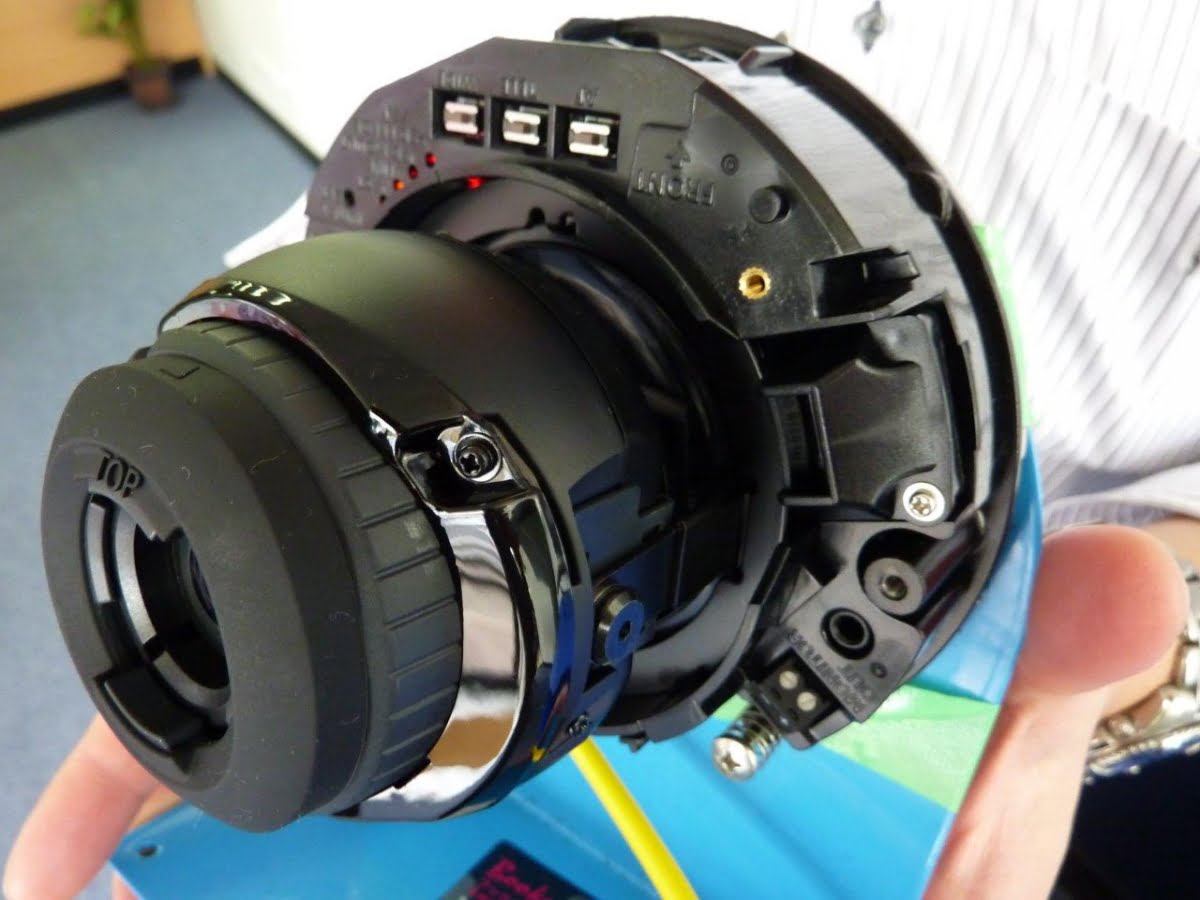
View from the front
Something else that’s new with 6 Series is smart depth of field – SmartDOF. According to Sekiguchi, it offers the same effect as a P iris lens in terms of enhancing depth of field but instead of a P iris, Panasonic balances shutter and aperture to improve focus throughout the depth of field.
“There’s also a motorised zoom lens for all domes now,” says Sekiguchi. “We launched the SW316L a bullet camera with a motorised zoom 2 years ago and we had a lot of feedback from installers who really liked it. Now all Series 6 cameras have a 3x optical zoom motorised lens.”
Something else that’s been a driver of sales over the past couple of years has been increasing ease of installation. With the 6 Series, Panasonic has put more thought into this side of its solutions.
“Our competitors have been increasing their ease of installation but we think our new camera is superior to the market leaders in this key area,” Sekiguchi says. “We have a simple installation with four 45-degree tamper screws and all our dome cameras have the same simple fixings.”
The new camera has a vandal-resistant, tamper-resistant enclosure and its IP66-rating is in 3 dimensions so there can be water in the ceiling and the camera will not leak. The 6 Series is also capable of handling low height ceilings and can get a horizontal shot through the curved dome without distortion. And you can select a sunshade option.
The 6 Series also has VMD inside the camera. These motion detection capabilities include intruder, loitering, direction, scene change, leftover, removal and line cross. Something else in 6 Series that Panasonic has not offered before is uploadable applications.
“This is our first camera with an open interface that can handle apps,” Sekiguchi explains. “We will launch Panasonic apps and we will open development to VMS partners, analytics partners, cloud service developments, prodigal apps for industrial applications. China has a lot of energy applications – they want to develop a Chinese prodigal app to service these sorts of industrial facilities.”
In modern cameras, bit rate management is another major issue.
“We have a lot of bit rate modes,” Sekiguchi explains. “It was for a long time Panasonic’s philosophy to build a camera that does not burst (exceed its bit rate) on movement. If you set one of our cameras in any mode – say at 4Mbps – a camera can never exceed that bit rate.
“But we found other makers were bursting their bitrates in particular applications. So we added a mode called advanced ABVR that allows a camera to burst its bitrate up to 4x if there is really major movement in a scene – it allows the camera to catch up the image quality to the movement.
“This mode can also help you maximise your HDD capacity. The camera will ensure it records at the maximum bit rate so as to maximise image quality and HDD space. So you never fall short (waste capacity that could have been used to enhance image quality) or go over (fail to achieve desired recording retention). It’s a unique feature – a calculation by accumulation.”
Something else that’s neat, the new camera can crop faces and send JPEG images at 128 x 128 pixels to a VMS which supports Panasonic camera face detection for analytics, or to a Panasonic Face Analytics Server for face matching or for face search, while still sending real time H.264 video streams for recording and viewing. This makes matching easier for VMS-based face recognition by reducing demand on a remote server, where the Panasonic camera takes over that job.
“We have VMS makers working on this with us,” explains Sekiguchi. “The camera works in tandem with our face recognition server to do real time face matching and face searching of past recordings. Panasonic Face Server will plug into an existing solution and work with 6 Series face cropping.
“When we do our cropping, the camera can handle 8 faces per 200ms (5 images per second), which is sufficient for any application. The camera selects the 3 best versions of a person’s face and sends them to Face Server. It’s a new feature for 6 Series but cameras must collaborate with Face Server or another face recognition server, which supports the Panasonic camera face cropping function.”
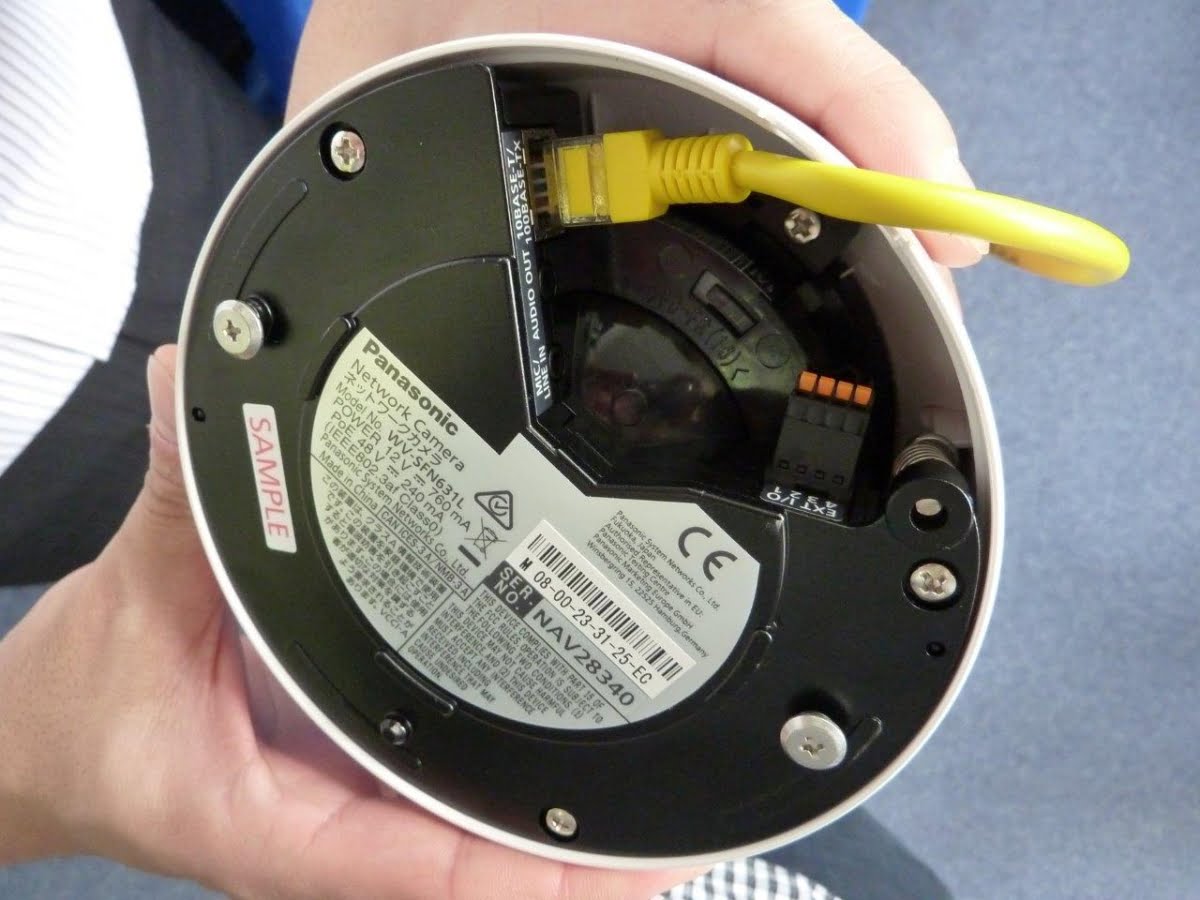
PoE and external I/Os – the simplicity of modern infrastructure
Workstation demo
Next comes the workstation demo in the Pacific Communications’ control room. First we look at a demo of current Super Dynamic and new Enhanced Super Dynamic 6 Series. Comparing the 2 you can see the dark areas get better identification and are brighter with 6 Series. The ESD-power 6 Series is showing clouds in the sky but we don’t see that with the older technology.
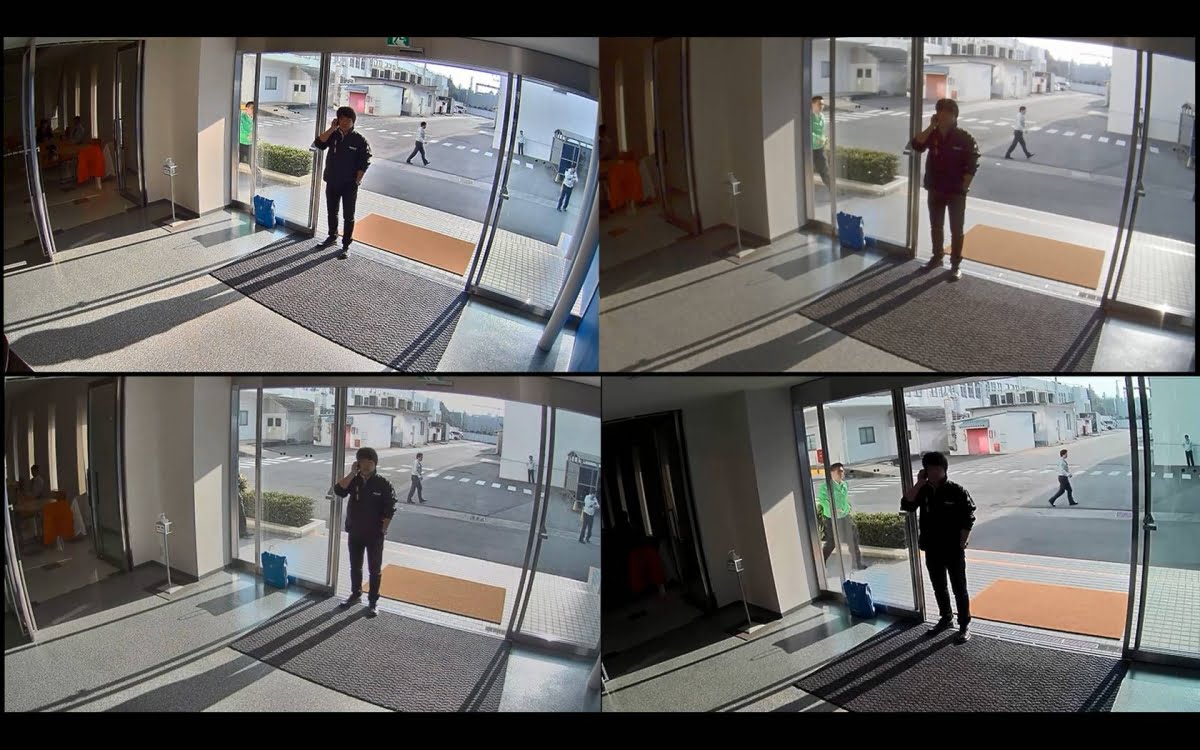
Backlight performance – Panasonic 6 Series with 138dB of WDR is top left
Next we look at a low light scene with light levels around 0.1 lux. Low light scenes are tough for camera manufacturers. You wind up camera gain to perform better in low light and wick up NR to clean up the noise generated by gain, but in doing so you lose contrast and colour rendition, adding more blur so moving objects look like ghosts.
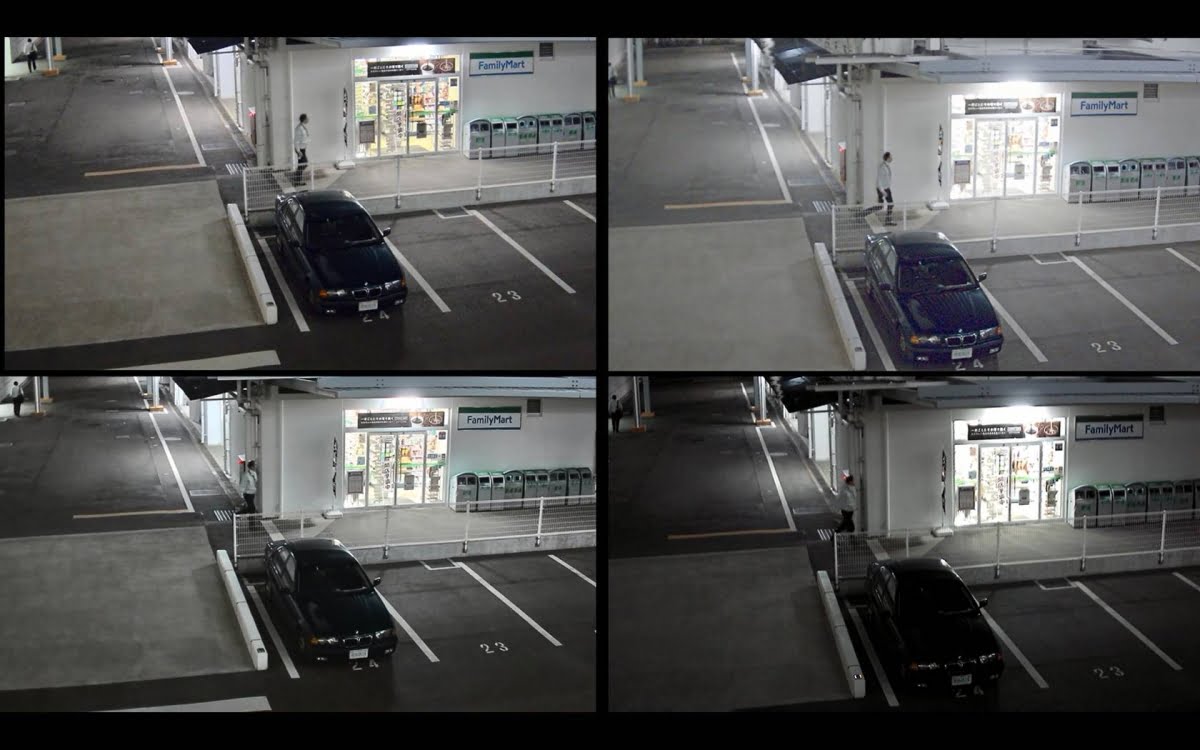
External low light application – Panasonic 6 Series is top left
There are 3 other cameras in the demo footage. I ask which cameras they are and when Sekiguchi tells me, I realise they are the best CCTV cameras in the world. Panasonic’s new 6 Series is not disgraced in this company and in key areas it looks to me to be doing better than the competition.
According to Sekiguchi, at all times the engineering team has been working to exceed the performance of the best cameras on the market when challenged by moving objects in low light and back light. As we’ve discussed, finding this balance is difficult.
Sekiguchi plays the footage and as we look at the camera views in this 0.1 lux scene it’s clear that static scenes are not too bad but as soon as there is movement the cameras starts to show varying degrees of the ghosting which is a sign of too much noise reduction – NR. These images almost look smooth with the amount of processing going on.
One camera seems to lose resolution across static low light scenes when objects start moving and the processing favours areas of movement. This makes the image appear flat when compared to the Panasonic. Looking at this scene I can see what Sekiguchi was talking about.
In this scene the Panasonic camera is offering high optical sensitivity with a minimum scene illumination of 0.1 lux while holding some colour.
Comparatively the 6 Series is holding a little noise but delivering superior contrast and very little or no visible ghosting of moving objects – including vehicles and people. The 6 Series camera is doing best in this scene, I think.
“We prefer to accept some noise in exchange for identification,” Sekiguchi tells me. Looking at these images it’s impossible not to agree. The trade-off makes for a superior overall image.
Now we look at 1 lux – a scene that includes detail, colour and movement. In my mind 1 lux is about as low as real world applications with typical depths of field should ever go without some illumination. Things start getting swimmy under 1 lux and while you might get an idea of what’s happening, in deeper scenes it’s going to be extremely challenging to get a return on your surveillance dollar without additional illumination.
As we look at the image streams it’s really interesting to compare these very strong cameras and see the different compromises their engineering teams were forced to make to try to offer the best possible performance. One camera is not really handling the demo situation all that well – it’s noticeably worse than the others. The next camera has much the least noise – a lovely smooth image. But it’s also the least bright, with the poorest colour rendition – the reds are going to brown. And when there’s movement, we lose significant contrast and with it, clarity.
Still another camera has slightly more noise and better colour reproduction and contrast, you can see small details quite clearly. But again, the Panasonic is doing best to my eye. A little more noise but much better colour, contrast and ability to handle movement without the appearance of anything spooky. It’s noticeable that moving figures are not dragging a wake of noise behind them.

Sunset – Panasonic 6 Series is top left – see how performance stays strong deeper into the scene that the competitors
Now we look at a difficult sunset scene. It’s late afternoon going into evening – witching hour for IP cameras. The foreground is growing dark, headlights are on, but the rear of the scene is sun-bright. The scene tails off across the highway into buildings and away to hills in the background, then sky. It’s an extensive depth of field.
The camera is at right angles to the major traffic stream at a range of about 12-15 metres and there are pedestrians crossing much closer to the lens – perhaps 5m away. The differences in this lighter scene are more subtle than those of previous demos we’ve looked at. Things that vary are visible resolution differences, the reflections on the sides of cars, branches in treetops, the fine contrast that delivers a sense of depth of field, the blooming of oncoming headlights across the intersection.
Again in this scene, we can see what the different manufacturers are doing to get the best images. Noise reduction on a number of the cameras is clearly polishing out the little details, the reflections in paint work. When vehicles whizz by or pedestrians walk by at right angles, you are losing any ability to identify them or their clothing with the overuse of NR. You can see the resolution melting, the reflections dulling. There’s a difference in the depth of field – some of the cameras seem flatter, with less contrast, less detail. The amount of processing work on some cameras – perhaps because it softens contrast – makes views appear 2-dimensional.
“Low light performance is a very important…We use multiple new technologies to achieve this strong performance – included advanced sensors and processing, and integrated IR”
These are the best 2, I say, pointing to the 6 Series and the camera that has been closest to it throughout the demo. But again, in this scene the Panasonic is doing better. It’s getting some number plates and some face recognition of pedestrians. You’re not getting the same clarity with the others. There’s better colour rendition, too. And again, the secret looks to be slightly higher gain – a bit more noise in the scene in exchange for superior overall image quality.
“Sunrise and sunset are only 30-minute windows – not that important people might say – but these are the most challenging times of the day,” explains Sekiguchi. “Panasonic cares that its cameras provide 24-hour coverage of scenes – including sunrise and sunset.
“Looking at this scene over time you can see that sunset is very tricky. As the sun sets and you view a group of cameras, one camera will look better, then the light levels will drop slightly and a different camera will look better. Or a previously good image might suddenly look terrible.”
I decide it might be easier in terms of comparison to focus on the 2 best cameras for a while, so Sekiguchi calls up those cameras and we compare them again, this time in a scene with about 8-10 lux. We’re looking for the presence of ghosting in areas of movement. Both are handling this scene much more than adequately but once again, while one has less noise, it also has more ghosting on movement. Here, too, I would pick the Panasonic over the competitor. In this case it seems to be handling flare from a shop window very nicely. We are able to peer inside the store.
“We raise gain so we get less ghosting but more noise and in the real world this balance works better,” Sekiguchi says. “The camera handles backlight so well.”
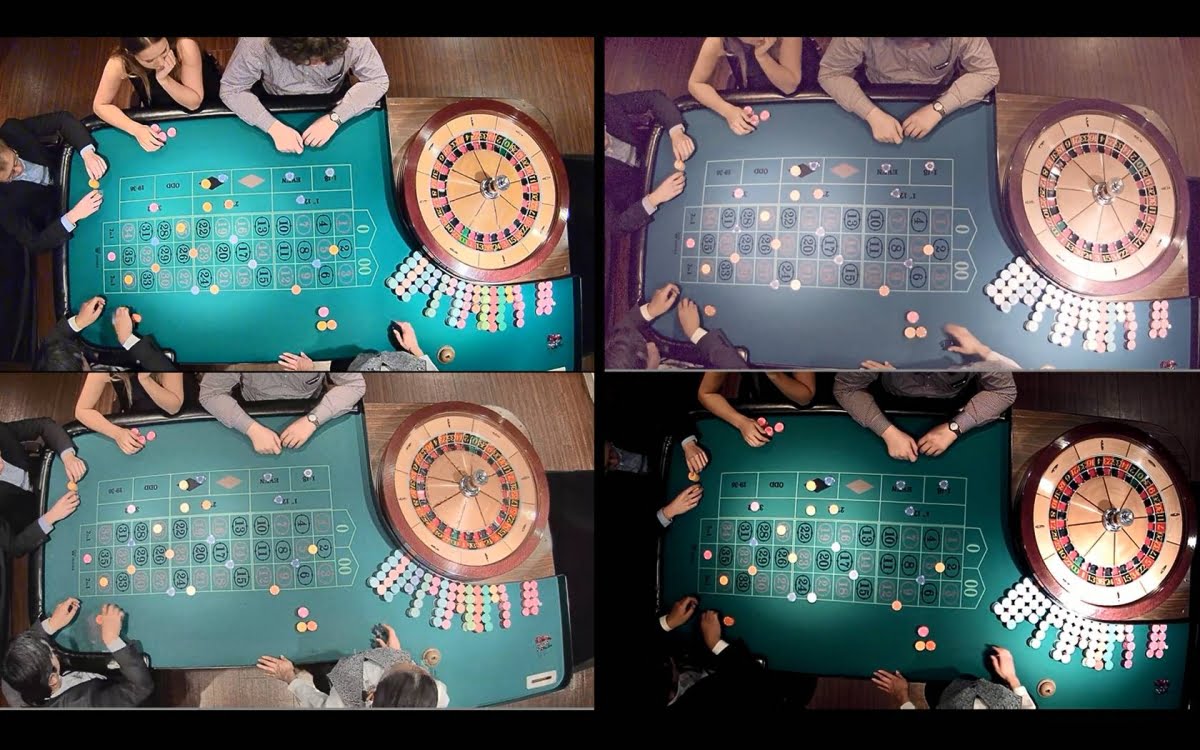
Casino application – again Panasonic 6 Series is top left
Our final scene is a casino with a number of camera views including card games, roulette wheels and stacks of chips. It’s another challenging scene (all these scenes are tough), with low overall light combined with strong light blooming off cards on the table, quick movements, and the need for high contrast and excellent colour rendition. In such scenes security teams need to identify people around the table, as well as chips, cards and movements on the table.
I think Panasonic is doing better than the opposition in this scene. The second camera again comes the closest in performance but its contrast is not as good. All the cameras are doing generally well here – there’s more available light than some of the other scenes. But one of the cameras has some colour issues, with another we can’t identify the players – they are simply disembodied hands on the baize.
Camera 2 is doing well with colour but there’s less richness and a loss of contrast around some items when compared with the 6 Series. Here, too, the Panasonic has a touch more noise. There are immutable laws relating to current technology which see amplification used to deliver superior performance in low light generating unwanted noise, while noise reduction flattens colour and eats away at contrast.
Local demo
Now we turn to our local demo – comparing the current and new Panasonic cameras. It’s a day with plenty of glare – low medium cloud and a lot of sun behind. There’s around 2000 lux outside though it seems like there’s more. On this site the sun is coming from the left hand side of the main foyer window – that’s North. Inside the foyer, light levels are around 200 lux, which is quite high – reflecting the amount of plate glass in this space.
In this application there’s an existing camera in the foyer and the new 6 Series is sitting on a table aimed at the same view while we compare images in the control room. There’s a lot of glass so we have plenty of backlight. The new model is doing better with backlight. Face recognition at the entry is distinctly superior. The 6 Series also looks to me to show more detail – a deeper field – clearer definitions of leaves outside the windows.
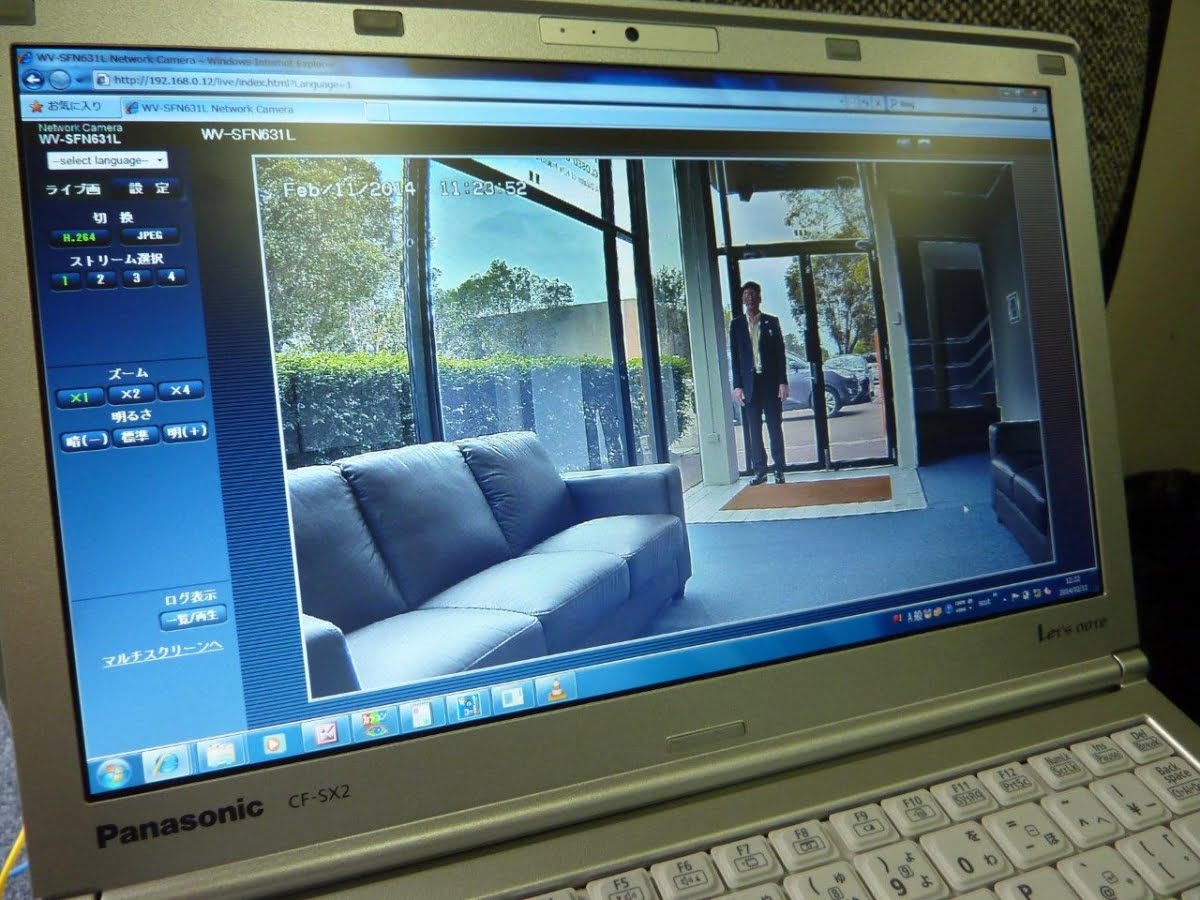
In the Pacom foyer – strong with WDR and depth of field – colours good despite grey day
It’s not an easy day – grey – and this tends to iron out colours reflecting off the scene. No blue sky, no unfiltered light but plenty of glare. The new camera is doing well in distance views up to 25m. Bear in mind, this is a dome camera with a very compact 3x optical lens. A box camera with a larger lens would do better at distance work but this camera is handling the scene very well.
Outside the window in the detail of leaves you can see a difference with 6 Series. There’s strong contrast throughout the scene. In this application the new camera is noticeably superior to the old – I think it’s handling movement in the scene better, too.
Conclusion
My initial impressions are that this is a strong release. It has good baseline capabilities – good low light, the strongest WDR numbers in the business, good optical performance with a 3x zoom, flexible streaming capabilities, IR for scenes with no light at all. And there’s a lot going on in the back ground, too. Twin SD slots, face cropping, IVA – it all adds up. And according to Sekiguchi, there’s plenty to come.
“We are planning a polarised filter to see into vehicles and see through reflection from cards in a casino – at the back end we are thinking about RS-485 and optical outputs, BNC for local monitors, optical fiber output for long distance transmission applications and additional SD slots, Wi-Fi, even M2M cameras with SIM cards for outdoor applications deploying across 3G and 4G networks. There are a lot of things we are working on, a lot of things to look forward to.
“I’m very excited with Series 6 – I feel that at last we have a platform we can start fighting with,” Sekiguchi enthuses. “During the process of development I really pressured our engineers – I want casinos, I want sunset, I want day time, I want WDR, I want night time performance in street surveillance applications with depth of field, I wanted everything.
He laughs.
“But you can’t gain something without losing something. It is a delicate balance, a compromise. We are continually working to improve performance. Firmware is always being updated. We are still working on our balance with gain and noise to make the scene superior. I think our engineers have done a good job.”
Later on I reflect that Sekiguchi’s deference doesn’t laud this new camera enough. Having had a good look at Panasonic’s 6 Series in the flesh, it seems a very good compromise to me.
By John Adams
“You can’t gain something without losing something. It is a delicate balance, a compromise. We are continually working to improve performance”



